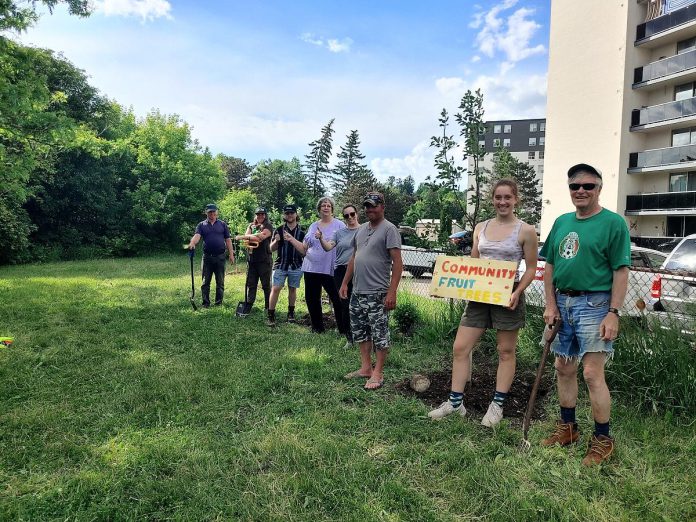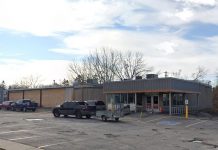
Close your eyes, and envision yourself standing in a local park that has a vibrant orchard, bursting with abundance.
Smell the blossoms in the spring, and hear the bees buzzing around them. In the summer, witness children’s delight as they pop berries in their mouths, see their fingers stained with sweet juice, and notice the gentle conversation of two old friends who talk quietly as they pick from the same rows of plants.
In the fall, taste the sweet cider, and enjoy the company of neighbours as you share in the harvest. In the winter, hear the crunch of snow underfoot as a team of volunteer fruit tree caretakers come out to prune the fruit trees to prepare them, just in time, for spring to arrive again.
Open your eyes. This might not be the scene at your local park now, but it could be in the next few years.
Momentum is building to grow our city’s edible infrastructure. Last spring, in partnership with Nourish and the City of Peterborough, 40 apple and pear trees were planted across the city. To continue towards a shared fruitful vision, this fall mini food forests will be planted in five Peterborough/Nogojiwanong neighbourhoods.
These mini food forests will consist of several fruit trees, berry bushes, and edible perennials. Here at GreenUP, we are excited to be working with a committed group of volunteers who will be planting and caring for young edible plants in these communal green spaces.
Would you like to feel more connected to the land and your food? Fruit trees and food forests can help connect individuals to each other and help communities better understand the source of their food, allowing for greater food sovereignty.

We often think about fruit growing taking place in vast orchards outside of urban areas, but increasingly, people are coming back to the idea of growing fruit close to home — in backyards, along boulevards, and in parks and open spaces.
The Community Foundation of Greater Peterborough provided capacity for Peterborough neighbours to connect virtually throughout the pandemic around the topic of fruit through GreenUP’s neighbourhoods programs, increasing their understanding of how fruit can be built into city infrastructure. This project has truly grown!
“Over the duration of the pandemic, we have seen the interest in growing food expand substantially,” explains Jill Bishop, Community Food Cultivator with Nourish. “Community members are enthusiastic about feeding themselves and their communities.”
“New and experienced gardeners alike have been asking frequently about integrating fruit production into their gardens and, as a community of growers, we have been dreaming about collectively planting fruitful food forests for years,” Bishop adds. “We are very excited about this project and the opportunity it presents to grow both fruit and our fruit-growing skills together as a community.”
Increasing edible infrastructure in cities brings a myriad of benefits to plants, animals, and people. Even before edible plants mature, they act as habitat and food sources for biodiversity within the seven different layers of the urban food forest canopy. Crucial pollinators are invited into the city space and contribute to the overall diversity of our urban landscape, creating ecosystem resiliency over time.
Contributing to a community food forest project is fun, engaging, and interesting. While volunteers tend to the growing plants, the green spaces are brightened with visitors who don’t normally use those areas, bringing the community closer together. People connect to nature and learn about where their food comes from. This increases health and wellbeing in communities over time.

We are thrilled to have the opportunity to grow more edible infrastructure in our city, but it requires tender love and care. Food forests are interactive spaces. Trees and shrubs respond well to watering, feeding, pruning, and picking. While caring for fruit is less intensive than maintaining a vegetable garden, it still requires attention. As the saying goes, “Many hands make light work.”
Would you like to help water, spread mulch, and prune? Would you like to check on the trees, organize picking parties, and help make sure signage looks clear and welcoming? Would you like to learn about fruit tree care and help share that knowledge with others?
We invite folks to get involved in fruit tree care through our Growing Edible Infrastructure project.
Throughout September we will have opportunities for volunteers to join us for some skill-sharing sessions, including hands-on opportunities to help plant edible infrastructure after diving into fruit tree teachings from knowledgeable volunteers.
Check out www.greenup.on.ca or register here and help us bring this vision to life.
Through GreenUP’s neighbourhood programs, we’ve learned a lot about the need for supporting more diverse use of shared space. For all these reasons and more, we are thrilled to be working on this Growing Edible Infrastructure Project as proud partners of the Arbor Day Foundation. The project is made possible by partnership with the Arbor Day Foundation and TD Bank.


























